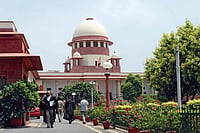Prime Minister Narendra Modi is set to inaugurate the new Parliament House in Delhi on Sunday.
The inauguration of the Parliament House would take place amid a boycott by most of the Opposition parties as they say President Droupadi Murmu and not Modi should be inaugurating the new building.
Despite the protests, the Centre has gone ahead with the inauguration. The new Parliament House is key part of the remodelling of the Lutyens' Delhi under the Central Vista Project.
Here we explain why the Modi government constructed the new Parliament building, what are its features, and what are the controversies around it.
Why was new Parliament House built?
Prime Minister Narendra Modi laid the foundation stone for the new Parliament House on December 10, 2020.
Modi described the foundation-laying as a "milestone in India's democratic history", asserting that if the old Parliament House gave direction to the country post-independence, the new one would be a witness to the making of an Aatmanirbhar Bharat.
The Central Vista Project, which includes the new Parliament House, was approved by the Modi government in 2019. The decision and subsequent land and environmental clearances were challenged in the Supreme Court, which ruled in favour of the government in January 2021.
While the decision to build the new Parliament House was taken in 2019, it was in the pipeline for several years.
In 2012, the then-Lok Sabha Speaker Meira Kumar gave approval for a high-powered committee to suggest an alternate complex to the old parliament house, according to an IANS report from the time.
The then-Lok Sabha Secretary General TK Viswanathan said that there was need for an alternate complex as the existing building was heavily used and could not take the strain, according to IANS.
In 2021, Union minister Hardeep Singh Puri said the older parliament complex had become unsafe over the years and had other limitations too.
He said, "The number of members (parliamentarians) has been increasing since we became an independent country. So, there have been a lot of internal adjustments and new facilities have been added...from a purely structural point of view, it is an unsafe building. When the building was constructed, it was in Seismic Zone II and today, that area is in Seismic Zone IV. It is not an exaggeration. We don't want to create panic, but you know you are above pushing the limit."
The Central Vista Project's website also says the previous Parliament House is a "distressed building".
"Over the period addition in services like water supply lines, sewer lines, air conditioning, fire-fighting, CCTV, Audio Video system, which were not originally planned, have led to seepages and destroyed the overall aesthetics of the building. The fire safety is a major concern as the building is not designed according to the present fire norms. Numerous new electric cables have been put up which are potential fire hazard," says the website.
Besides the Parliament House, the Central Vista Project also consists of a common central secretariat, revamping of the 3-km Rajpath (now Kartavya Path) from Rashtrapati Bhavan to the India Gate, a new prime minister's residence and office, and a new Vice President's enclave. Tata Projects Limited has constructed the new Parliament House.
Timeline of the new Parliament House
2019: The Central Vista Project was announced by the Government of India.
2019: HCP Design Planning and Management Pvt Ltd was awarded the contract to draw up architectural plan for the project.
2020: Tata Projects Ltd was awarded the contract to build the new Parliament House. Initially, the cost was estimated to be Rs 862 crore. Last year, however, NDTV reported that the cost had increased by 29 per cent to over Rs 1,250 crore.
2020: On December 10, Prime Minister Narendra Modi laid the foundation stone for the construction of the new Parliament House.
2021: In January, the Supreme Court cleared the construction of the Parliament House. Later that month, the construction of the new Parliament House began.
2022: Modi unveiled the Indian national emblem to be put atop the Parliament House. The bare fangs of the lions in the emblem led to controversy.
2023: Modi is set to inaugurate the Parliament House on May 28 amid controversy over who should inaugurate. Critics and most of the Opposition have said that President and not the Prime Minister should inaugurate.
Features of the new Parliament House
The new Parliament House has more space and seating area than the previous one. It will also be a 'smart building' which would minimise paper usage.
"Furniture in the debating halls will include smart displays and biometrics for ease of voting with intuitive and graphical interface; digital language interpretation and recording infrastructure to produce real-time metadata; and programmable microphones," says HCP Design Planning and Management Pvt Ltd.
HCP further list the following features of the Parliament House:
- It will house larger Lok Sabha and Rajya Sabha halls, with capacities of 770 seats and 384 seats respectively.
- The Lok Sabha hall will also have additional capacity, up to 1,140 seats, to host joint sessions.
- There will be essential facilities like committee rooms, major offices of the Ministry of Parliamentary Affairs, Lok Sabha Secretariat, and Rajya Sabha Secretariat.
- There will also be publicly accessible museum-grade galleries and exhibits.
- There will also be a Constitution Hall and gallery.
"The central Constitution Hall and Gallery will showcase the Indian Constitution and other artefacts of India’s heritage, symbolically and physically putting people at the heart of the Indian democracy," says HCP Design on its website.
What are the controversies?
These controversies have covered most aspects of the construction, ranging from the foundation-laying to inauguration.
The project has been criticised as being Modi's personal vanity project and unnecessary, particularly in the midst of Covid-induced economic hardships.
Earlier this month, the Congress called the project "personal vanity project" of Modi. Sharing a photo of Modi inspecting the Parliament building, Congress leader Jairam Ramesh tweeted: "The sole architect, designer and worker for the new Parliament building, which he will inaugurate on May 28th. The picture tells it all—personal vanity project."
The fact that the new Parliament building is being inaugurated on birth anniversary of Hindutva ideologue VD Savarkar is being criticised. Accused in the Gandhi assassination case and criticised for views considered by critics as anti-Muslim, Savarkar remains a deeply polarising figure in Indian polity.
Mahatma Gandhi's great grandson Tushar Gandhi said Modi should name the new Parliament House "Savarkar Sadan", according to Mirror Now.
A group of 69 former bureaucrats earlier called the project "wasteful and unnecessary". Writing about the broader Central Vista Project, under the aegis of Constitutional Conduct Group, they claimed that the country's public health infrastructure was crying out for investment and asked why this "wasteful and unnecessary project must take precedence over social priorities like health and education".
Most recently, most of the Opposition has boycotted the inauguration of the new Parliament as it's being done by Modi, not President Murmu.
(With PTI inputs)


























